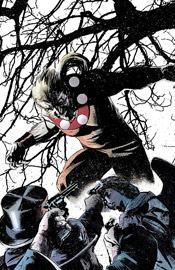
Well, to an extent, something does. Their status outside the current continuity, separated forever from everything they’ve ever held dear, gives these characters a common sadness that binds them together like strong glue. Chris Claremont’s story is surprisingly light on dialogue and full of interest and potential. When the team loses contact with one another after a mission, they’re scattered across time and space with no immediate means of reaching one another. Claremont gives each character’s new locale a look and feel all its own, complete with an immediately interesting supporting cast. It feels like the beginning of an epic story, covering several issues before even coming close to a conclusion. But then, around the halfway mark of its very first issue, the epic suddenly concludes.
It’s like a light switch is flipped. Suddenly, Claremont’s tendency to overcomplicate a solid foundation is evident, as he abandons what looked to be an intriguing direction in favor of another far-reaching, long-winded, high-concept mess. Reading the first half of this book, immediately followed by its conclusion is a horribly disjointed experience. It’s like he finished the first nineteen pages of script, realized that he wasn’t going to have time to reach a conclusion before the end of the upcoming 100th issue, and hurried to reach a point that he would.
Artist Clayton Henry is asked to straddle a lot of different styles in this book, and he manages to do a decent enough job. While he’s given carte blanc with some of the lesser known characters, the Age of Apocalypse characters and Spider-Man 2099 are naturally associated with some very distinct visual styles. Fortunately, not only do none feel out of place or uncomfortable in Henry’s hands, but they also fit in decently enough with their peers – which is very much easier said than done.
That’s not to say it’s all wine and roses. Henry does a decent enough job at capturing the styles and personalities of these characters, but none feel as dynamic or exciting as they did in their original interpretations. His style is fundamentally strong, but with a nasty tendency to turn the amazing into the humdrum. When one new character surprisingly bursts into flames, it’s treated so casually that the effect is lost on the reader. If the characters aren’t surprised by these developments, why should the readers be?
This book has a lot of potential, and it had nearly pulled me in when Claremont tore his initial concept away from us. I like these characters, and I like the way they interact with each other. They have some chemistry together, and while he’s not knocking my socks off on every page, Clayton Henry at least knows how their worlds should visually intertwine. It’s a shame that the initial plot wasn’t given enough time to simmer before reaching a boil, because I think it could’ve really been something special, something that’s right down Claremont’s alley. I’m going to suggest you flip through this, which is a shame because it was right on the verge of being something more.
Overall Score: 6

No comments:
Post a Comment